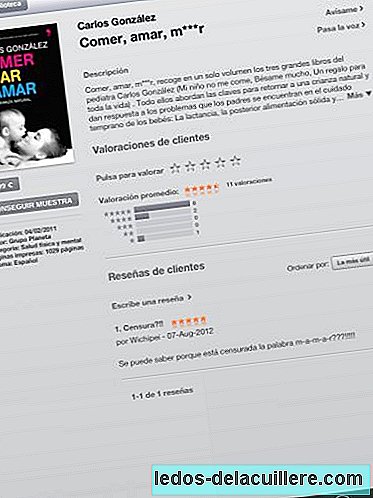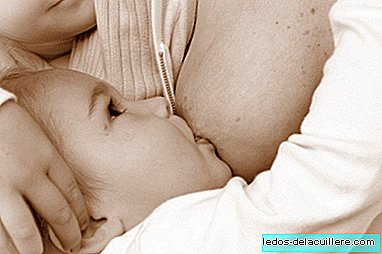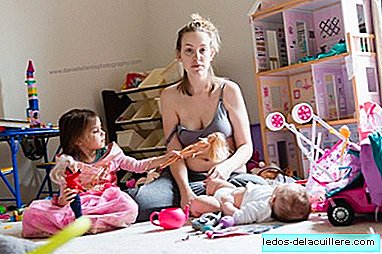A few days ago we talked about an invention devised by three nurses that is revolutionizing the world of caesarean sections. It is a kind of sheet with a window that allows the mother to take the baby with total security as soon as she is born.
Following this post, many of you have commented on our Facebook page something that left me very impressed: that you have not been able to touch your babies at birth because they are tied by the arms. Sounds like last century, but it seems that it is still in force in some places the practice of tying mother's hands in cesarean deliveries.
What is the purpose of tying the mother?

According to comments from women they have tied in their births, arms extend to the sides in the shape of a cross, one of them with a route for serum (and probably also another medicine), and on the other, a device that measures tension.
There are those who comment that they were not tied, but they have put some splints in their arms that prevent them from moving.
Apparently, the purpose is to prevent the mother, in a reflex act, can put her hands to the belly and compromise the sterile area while the cesarean section is being practiced.
The question is, Is it really necessary to tie the mother to prevent this possible contamination? Isn't there a more respectful way to do it? Less violent?
A nurse who is aware that this does not happen, or better yet, the father, allowing him to attend that special moment while reassuring the mother ... Surely there is a kinder way that does not make the mother feel hindered.
Testimonies of women who have been tied
I want to leave the comments retrieved from our Facebook profile in which several readers told their experience, many from Latin America, but also Spanish.
One who has had a caesarean section is practically crucified on the stretcher full of needles, I could not move, just kiss my son who brought him super wrapped, but hugging can not. (Jecsabel Spinohza Abarca, Chile)
Well, in El Salvador it wouldn't help us much because they tie you up here. That way you can't hold the baby. They just approached me to kiss him and nothing else. (Joh Lovo de Alvarez, El Salvador)
In Lima Peru too, both hands are tied and they only put it on you to give you a little kiss and they take it and one goes to the recovery room for several hours. (Sandra López Liñán, Lima)
To me in Barcelona too, it looked like Jesus Christ but I think it's because of the tremors they give and the devices that connect you. (Sonia Costa, Barcelona, Spain)
In Mexico too, but they told me that because I was shaking a lot and it was so that I didn't fall and they cut me badly. (Mariela Arce, Mexico)
I do, but come on, at that moment I did not care, you are full of cables, the road, you want to see your baby. (Moni Ten, Campo Real, Spain)
I was bound hand and foot with local anesthesia. (Yesy Schwarzenberger, Argentina)
They tied me too, it's like being crucified (Vicky Santi Valen Hanna, Uruguay)
Well here in Madrid, in La Paz, you are also tied (Raquel Rey, Madrid)
Skin with skin, also with caesarean section

The mother's early contact with the baby at birth is essential to establish a bond of attachment and promote breastfeeding. The first hour of life is sacred to the mother and the baby, it is a especially sensitive period in which hormones play a very important role in favoring affective imprint between both.
The baby needs to be in contact with the skin of his mother and breastfeed from his chest (something he will do instinctively if we leave him) and at the same time, the mother needs to touch, smell and hug her son just out of her belly, even with the cord still beating. They need closeness to each other.
Because of this biological mechanism that starts after delivery, A newborn should never be separated from his mother, no matter how he was born. Babies born by caesarean section would also have to stay in skin-to-skin contact with the mother. It is a practice that is gradually being incorporated into some maternity hospitals. What is incredible (and outrageous) is that in others the mother is tied, preventing her from hugging her baby.
A C-section can also (and should) be a respected birth.
Giving birth by caesarean section does not mean giving free stone so that woman's wishes are not taken into account. In the birth plan, that document that should be considered sacred and seems to be the role of the WC, you must state how you want to give birth, whether it is a vaginal delivery as if, under any circumstance, a C-section should be performed.
Some time ago we talked about a birth model that consists of giving birth by caesarean section as if it were a natural birth. A C-section that allows the father to be present and the mother to see the whole process, to the point that, if he wishes, you can take your baby inside herself. How can this practice of "assisted caesarean section" that is performed in some hospitals be tied away from one in which your arms are tied to immobilize you and you can barely touch your baby? Unintelligible.
More humanized births, please!
Have you been tied?
I thought that it was no longer done, that it was something from another era, so when I read your comments it seemed necessary to bring it to light. There are still many things to change so that the birth of a baby is a moment of happiness in which mother and newborn are the true protagonists of the process. If you had a C-section, we would like to know if your hands have been tied, if you were able to take your baby, or how your delivery was. Tell us your experience in the comments of the post.












